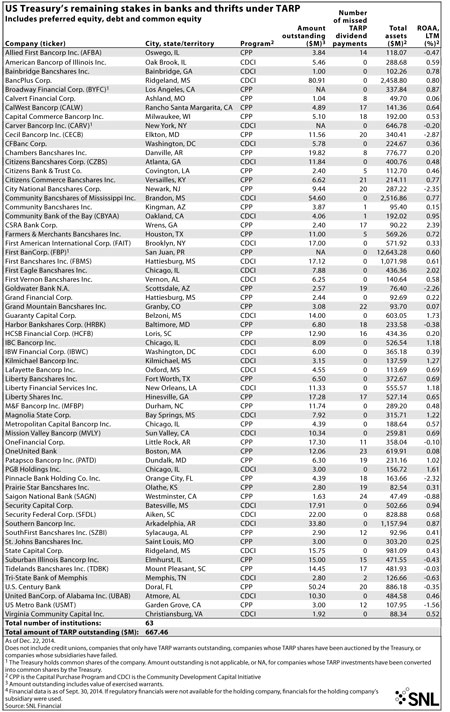Treasury still holds TARP stakes in 63 institutions
SNL Report: Ally stake gone, but others remain
- |
- Written by SNL Financial

By Maria Tor, SNL Financial staff writer
The U.S. Treasury still holds stakes in 63 banks and thrifts as part of the Troubled Asset Relief Program, which was signed into law over six years ago in 2008.
The government exited its largest remaining stake—in Ally Financial Inc.—on Dec. 19. Its remaining banks and thrifts, which it holds through investments in preferred shares, subordinated debentures, and common stock, range in asset size from just $47.5 million (Westminster, Calif.-based Saigon National Bank), to $12.64 billion (San Juan, Puerto Rico-based First BanCorp.).
The 63 stakes are in mostly smaller banks, with a median asset size of $289.2 million. The Treasury said on its website that it is focused on recovering TARP funds "in a manner that maximizes returns for the taxpayers" and promotes financial stability.
 For a larger version, click on the image.
For a larger version, click on the image.
Of those 63 banks and thrifts, 35 are part of the Capital Purchase Program, which was one of the first bank investment programs launched after the passage of TARP.
Under the CPP, the Treasury provided capital to banks in exchange for preferred stock or subordinated debt as well as a warrant to purchase additional securities. The banks then had to pay dividends or interest payments to the Treasury as part of the terms of the investment. Some companies later converted the Treasury's investment to common stock or trust-preferred securities in order to improve their capital ratios.
And 28 of the 63 companies are part of the Community Development Capital Initiative, which was launched in February 2010 to provide a cheaper alternative to the CPP for institutions that serve underbanked communities.
The initial dividend or interest rate under the CDCI is 2%, compared to the initial rate of 5% under the CPP. Additionally, the higher rate of 9% will kick in after eight years under the CDCI, as opposed to five years under the CPP. Twenty-eight banks that originally received funding under the CPP were allowed to exchange securities and become part of the CDCI instead.
As of Oct. 8, the Treasury also held investments in 109 institutions that had refinanced their CPP or CDCI securities into shares or debt issued under the Small Business Lending Fund. The SBLF is similar to TARP in that the Treasury provides capital to institutions in exchange for preferred stock or subordinated debt. The capital is meant to be used specifically to fund small business loans.
In all, the Treasury funded 707 institutions under the CPP. According to the Treasury's monthly report to Congress released Dec. 10, 254 of the institutions exited the program by repaying the Treasury. The Treasury exited 185 of the stakes by auctioning the shares or debt to other investors, and 137 of the companies refinanced their CPP shares to become part of the SBLF. The rest of the stakes were exited through sales or through the merger of CPP participants. Additionally, 32 of the CPP participants went into receivership or bankruptcy, giving the Treasury little to no chance of recovering the invested funds.
The 63 banks and thrifts listed in the table do not include institutions where the Treasury holds only the outstanding warrant issued under TARP. It also does not include the 36 credit unions participating in the CDCI.
Tagged under Management, Financial Trends,
Related items
- How Banks Can Unlock Their Full Potential
- JP Morgan Drops Almost 5% After Disappointing Wall Street
- Banks Compromise NetZero Goals with Livestock Financing
- OakNorth’s Pre-Tax Profits Increase by 23% While Expanding Its Offering to The US
- Unlocking Digital Excellence: Lessons for Banking from eCommerce Titans














